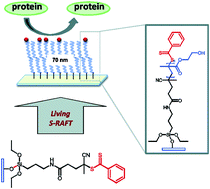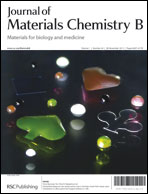Controlled growth of protein resistant PHEMA brushes via S-RAFT polymerization†
Abstract
The reversible addition–fragmentation chain transfer polymerization of 2-hydroxyethyl methacrylate (HEMA) from surfaces (S-RAFT) using an R-group-attached chain transfer agent (CTA) is presented. The approach was exploited for the efficient preparation of well-defined PHEMA brushes of up to 50 nm thickness in a controlled fashion without using any cytotoxic catalyst. The chemical composition, morphology and wettability of the samples were assessed by X-ray photoelectron spectroscopy, atomic force microscopy and water contact angle measurements, while the growth kinetics were studied by monitoring the dry thickness via spectroscopic ellipsometry. The mechanism and kinetics of the RAFT polymerization on the surface – in the presence of a sacrificial CTA and of solvent mixtures with different polarities – were investigated. A marked effect of the concentration of the sacrificial CTA on the kinetics was observed. Importantly – and for the first time – the living PHEMA brushes were exploited as macroRAFT agents for chain extension, and thicknesses up to 70 nm were achieved. The prepared PHEMA brushes were challenged with protein solutions demonstrating their resistance to fouling.


 Please wait while we load your content...
Please wait while we load your content...